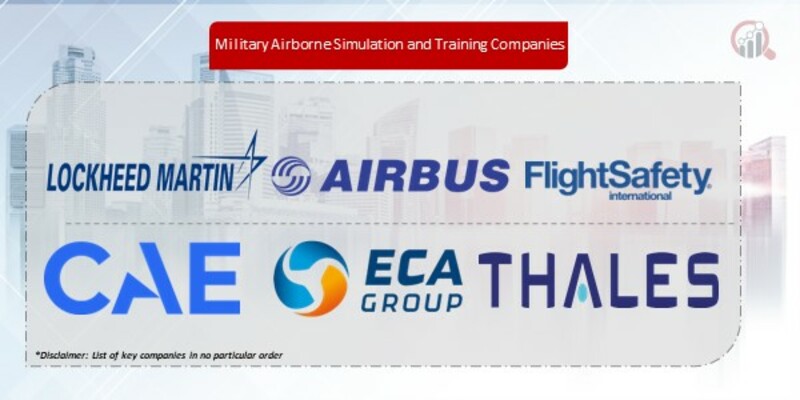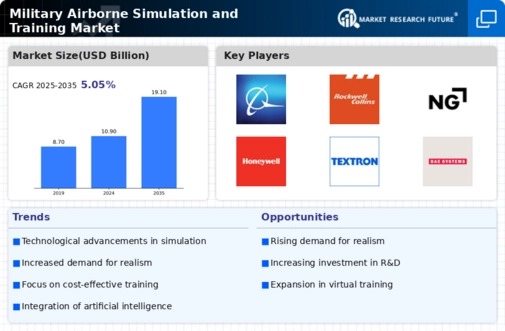Top Industry Leaders in the Military Airborne Simulation Training Market

Key Players
Lockheed Martin Corporation (US)
Airbus SAS (France)
FlightSafety International Inc. (US)
CAE Inc. (Canada)
L3 Link Simulation and Training (US)
ECA GROUP (France)
Thales Group (France)
FRASCA International Inc. (US)
SIMCOM Aviation Training (US)
AXIS Flight Training Systems GmbH (Switzerland).
Strategies Adopted
Industry news within the Military Airborne Simulation and Training Market often highlights successful contract awards for the development of simulation systems, collaborations between defense contractors and military organizations, and advancements in training methodologies. Companies regularly announce the deployment of new training solutions, participation in joint exercises, and successful integration of emerging technologies to showcase the effectiveness and relevance of their simulation and training offerings. Regulatory updates related to military training standards, government budgets for defense programs, and international collaborations in defense training also shape industry dynamics, prompting companies to align their offerings with evolving requirements.
Current trends in company investments within the Military Airborne Simulation and Training Market reflect a notable focus on virtual and augmented reality, artificial intelligence, and cloud-based training solutions. Companies allocate resources to develop advanced simulation systems that provide realistic and cost-effective training experiences for military personnel. Investments in data analytics and artificial intelligence aim to enhance debriefing capabilities, providing valuable insights into performance metrics and facilitating continuous improvement in training programs. Strategic partnerships, participation in industry conferences, and collaboration with defense agencies are common trends among key players to stay abreast of technological advancements and maintain competitiveness.
Emerging Companies
The overall competitive scenario in the Military Airborne Simulation and Training Market remains dynamic, with companies navigating evolving military training requirements, technological advancements, and defense budget constraints. Established players face the challenge of continuously innovating to meet the changing demands of defense agencies and ensure their training solutions remain cutting-edge. The competition is expected to intensify as emerging companies secure contracts, introducing novel technologies and challenging the market share of established airborne simulation and training solution providers. In this environment, adaptability, responsiveness to military training needs, and a commitment to technological excellence will be crucial for companies to maintain and enhance their competitive positions in the Military Airborne Simulation and Training Market.
Recent News
Received a $900 million contract from the Royal Canadian Air Force to provide comprehensive training services for the CF-188 Hornet fighter jet, including full-mission simulators and instructor-led training. This program ensures pilot proficiency and operational readiness for Canadian jets.
Launched a new immersive training center in Texas, equipped with advanced flight simulators and virtual reality (VR) training modules for various military aircraft. This center offers realistic training scenarios for both pilots and ground crew.
Partnered with Airbus to develop a next-generation pilot training program for the A350 airliner, combining traditional simulator training with augmented reality (AR) and VR modules. This collaboration blends modern technology with established training methods.
Won a $300 million contract from the U.S. Navy to upgrade its F-35 fighter jet simulators with cutting-edge AI and machine learning capabilities. This upgrade will make training more challenging and realistic, preparing pilots for complex combat scenarios.
Developed a new tactical combat training system utilizing artificial intelligence (AI) for large-scale military exercises. This system allows for simulated battles involving multiple aircraft, ground troops, and other assets, enhancing readiness for real-world operations.
Partnered with Boeing to create a joint venture focused on developing advanced simulation and training technologies for both military and commercial applications. This collaboration combines expertise from two leading aerospace companies.
Delivered its C-130J Hercules flight simulators to the Indian Air Force, equipping them with enhanced capabilities for pilot training and mission rehearsals. This technology strengthens India's military preparedness and training infrastructure.
Developing a new immersive training system for Special Forces operators, utilizing virtual reality (VR) and augmented reality (AR) to replicate complex combat environments and tactical scenarios. This VR/AR technology prepares Special Forces for real-world missions.
Partnered with academic institutions to research and develop next-generation flight simulator technologies, including biofeedback sensors and brain-computer interfaces. This research could revolutionize military training by incorporating advances in neuroscience.
Won a $160 million contract from the U.S. Air Force to provide training services for its KC-135 tanker aircraft, including full-mission simulators and instructor-led training. This program ensures proficiency in aerial refueling procedures for critical air-to-air support operations.
Developed a new training system for drone operators, utilizing artificial intelligence (AI) to simulate complex scenarios and adversarial environments. This AI-powered training improves the effectiveness and decision-making of drone operators.
Collaborated with the Australian Defence Force to develop a virtual reality (VR) training program for soldiers, focusing on combat skills and situational awareness. This VR technology provides realistic and immersive training for ground troops.










